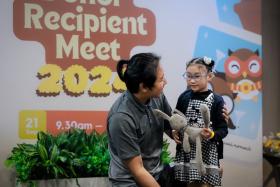He doesn't know whose life he saves and he's not bothered
He donated his bone marrow and saved a life, but for the foreseeable future, Dr Devanathan Raghunathan won’t know who he helped – at least for the next two years, and that too, under the condition of mutual consent.
But the identity of his benefactor didn’t matter to the 44-year-old healthcare professional, who said he understands the challenges and scarcity surrounding tissue and organ donations.
Bone marrow is the soft tissue inside the bones that produces blood stem cells, and it is these blood stem cells that are donated.
When Dr Devan learnt of the opportunity to donate his bone marrow, he registered without hesitation. It took about “five to six years” before he received a call from the bone marrow donor programme, informing him that he could potentially save a life.
“I was astonished to be presented with such a blessed opportunity,” Dr Devan said. “The situation became increasingly intricate as I am a diabetic, a condition I discovered only after my registration in the database.
“I understood that even if I were the most suitable match, there were elements that could affect my selection as a donor. So I felt a sense of relief when I was chosen to donate.”
He told tabla! that his wife’s family had suffered losses to hematological malignancies (cancers arising from abnormal blood or bone marrow cells) in the past, and their struggle to find suitable donors in India fuelled his determination to inspire change.
With the backing of his wife and two young daughters, along with discussions with his medical peers, Dr Devan moved forward with the peripheral blood stem cell (PBSC) donation, performed through a non-invasive procedure known as apheresis.
The process involves drawing blood from one arm via an intravenous tube, which then flows into an apheresis machine designed to separate the stem cells from the blood. The stem cells are collected for storage, while the remaining blood is returned through an intravenous tube in the other arm.
The procedure went smoothly and the recovery process took approximately two weeks, during which he periodically monitored his blood sugar levels before resuming work and his daily exercise routine.
“What if someone in our extended family needs assistance tomorrow? Often, we believe it won’t happen to us until it does,” Dr Devan said. “It’s vital for more people within our community to step up and contribute. Be the change you wish to inspire in others.”
He added: “If I were to donate my organs after my passing, I won’t know who will benefit from it. With a bone marrow donation, I can witness the impact within a few years and perhaps even meet the recipient. That would be an extraordinary experience.”
On Sept 21, in conjunction with World Marrow Donor Day, the Bone Marrow Donor Programme (BMDP) hosted an event where 10 bone marrow recipients met their life-saving donors.
According to BMDP’s guidelines, donors and recipients remain anonymous to each other for two years. And if both parties are interested to meet, BMDP helps to facilitate this.
As highlighted in BMDP’s 2023 report, there is a salient underrepresentation of Malays and Indians within its registry – Malays account for 8 per cent and Indians 9 per cent. This makes it challenging for patients from various ethnic backgrounds seeking a match, according to the report.
When discussing the challenges related to the underrepresentation of Indians in the registry, the BMDP cited a lack of public awareness on the topic that leads to stigmas surrounding bone marrow donation.
“Most people have the impression that bone marrow is taken from the spine; others think they are giving a part of their bone away,” said chief executive of BMDP Charles Loh.
“There are also cases of registered donors who face objections from family and loved ones. Family objections constitute one of the top reasons for donor drop-outs. So, we encourage family and friends to be more supportive and learn about bone marrow donation as well. You are not just saving a life. You are helping a whole family.”
In line with the underrepresentation of Indians, the BMDP collaborated with the Singapore Indian Development Association (Sinda) on Project Give last year, where a recruitment booth was set up at the Indian Heritage Centre.
“At our annual flagship event, Match For Life, at Our Tampines Hub on Nov 9, SINDA is participating as a partner by setting up a booth at our carnival,” said Mr Loh.
“With heightened support and awareness, we hope to reduce the drop-out rate and save more lives.”
join the bmpd register
If you are between 18 and 49 years old, and in good health, you can give a person-in-need a second lease of life. For more information on the Bone Marrow Donor Programme and how you can join the register, go to bmdp.org/join-the-register
Get The New Paper on your phone with the free TNP app. Download from the Apple App Store or Google Play Store now


